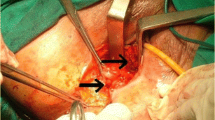Abstract
Forty women with low rectovaginal fistulas were operated upon over a 9-year period. The etiology of the fistula in the majority was obstetric. Nine women had prior attempts to repair the fistula. All 40 women were managed with endorectal advancement flap with the addition of sphincteroplasty or perineal body reconstruction in 15 patients and rectocele repair in six patients. Postoperative complications included urinary difficulties (two patients) and wound complications (three patients). There were two recurrences. All women treated with sphincteroplasty or perineal body reconstruction were continent. Seven women complained of varying degrees of incontinence postoperatively; none had undergone sphincter or perineal body reconstruction. Endorectal advancement flap is a safe and effective operation for women with rectovaginal fistulas. Concomitant sphincteroplasty or perineal body reconstruction should be performed in women with historical, physical, or manometric evidence of incontinence.
Similar content being viewed by others
References
Hibbard LT. Surgical management of rectovaginal fistulas and complete perineal tears. Am J Obstet Gynecol 1978;130:139–41.
Pepe F, Panella M, Arikian S, Panella P, Pepe G. Low rectovaginal fistulas. Aust NZ J Obstet Gynecol 1987;27:61–3.
Rothenberger DA, Christenson CE, Balcos EG,et al. Endorectal advancement flap for treatment of simple rectovaginal fistula. Dis Colon Rectum 1982;25:297–300.
Noble GH. A new operation for complete laceration of the perineum designed for the purpose of eliminating danger of infection from the rectum. Tr Am Gynecol Soc 1902;27:357–63.
Laird DR. Procedures used in treatment of complicated fistulas. Am J Surg 1948;76:701–8.
Hilsabeck JR. Transanal advancement of the anterior rectal wall for vaginal fistulas involving the lower rectum. Dis Colon Rectum 1980;23:236–41.
Lowry AC, Thorson AG, Rothenberger DA, Goldberg SM. Repair of simple rectovaginal fistulas: influence of previous repairs. Dis Colon Rectum 1988;31:676–8.
Jones IT, Fazio VW, Jagelman DG. The use of transanal rectal advancement flaps in the management of fistulas involving the anorectum. Dis Colon Rectum 1987;30:919–23.
Venkatesh KS, Ramanujam PS, Larson DM, Haywood MA. Anorectal complications of vaginal delivery. Dis Colon Rectum 1989;32:1039–41.
Stern H, Gamliel Z, Ross T, Dresznik F. Rectovaginal fistula: initial experience. Can J Surg 1988;31:359–62.
Russell TR, Gallagher DM. Low rectovaginal fistulas: approach and treatment. Am J Surg 1977;134:13–8.
Author information
Authors and Affiliations
About this article
Cite this article
Wise, W.E., Aguilar, P.S., Padmanabhan, A. et al. Surgical treatment of low rectovaginal fistulas. Dis Colon Rectum 34, 271–274 (1991). https://doi.org/10.1007/BF02090169
Issue Date:
DOI: https://doi.org/10.1007/BF02090169




